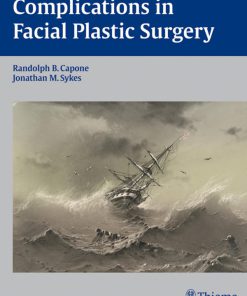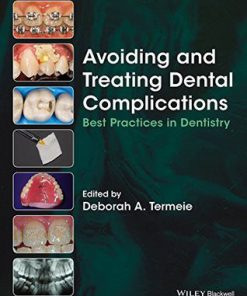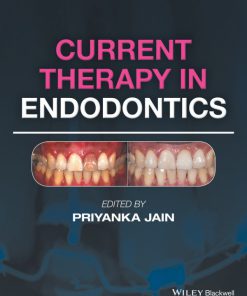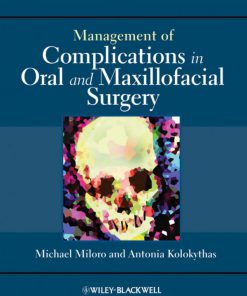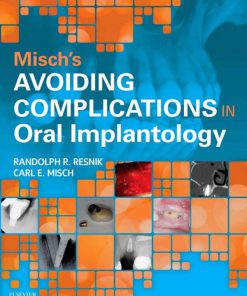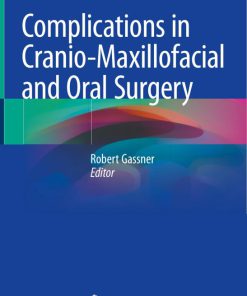Complications in Endodontics 1st Edition by Priyanka Jain ISBN 9783319609973 3319609971
$50.00 Original price was: $50.00.$25.00Current price is: $25.00.
Authors:Common Complications in Endodontics Prevention; Management-Springer International Publishing (2018) , Author sort:Prevention, Common Complications in Endodontics & Publishing, Management-Springer International , Published:Published:Nov 2017
Complications in Endodontics 1st Edition by Priyanka Jain – Ebook PDF Instant Download/Delivery. 9783319609973 ,3319609971
Full download Complications in Endodontics 1st Edition after payment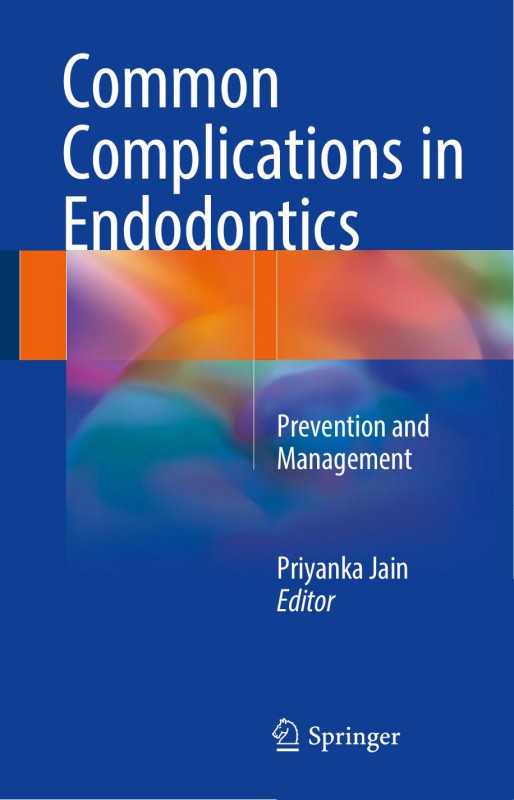
Product details:
ISBN 10: 3319609971
ISBN 13: 9783319609973
Author: Priyanka Jain
Complications in Endodontics 1st Edition Table of contents:
Part I: Diagnosis
1: Clinical Diagnosis and Treatment Planning
1.1 Introduction
1.2 Examination
1.2.1 History of Chief Complaint
1.2.2 Pulpal Diagnosis [7–12]
1.2.2.1 Normal Pulp
1.2.2.2 Reversible Pulpitis
1.2.2.3 Symptomatic Irreversible Pulpitis (SIP)
1.2.2.4 Asymptomatic Irreversible Pulpitis
1.2.2.5 Pulp Necrosis
1.2.3 Apical Diagnoses [7–12]
1.2.3.1 Normal Apical Tissues
1.2.3.2 Symptomatic Apical Periodontitis (SAP)
1.2.3.3 Asymptomatic Apical Periodontitis
1.2.3.4 Chronic Apical Abscess
1.2.3.5 Acute Apical Abscess (AAA)
1.2.4 Condensing Osteitis
1.3 Clinical Evaluation
1.3.1 Palpation, Percussion, and Periodontal Probing
1.3.2 Sensitivity Testing
1.3.2.1 Thermal Tests
Cold Test
Heat Test
Electrical Sensitivity Test
1.3.3 Biting and Release
1.4 Radiographic Evaluation and Diagnosis
1.5 Treatment Planning and Considerations
1.5.1 Strategic Value of the Tooth
1.5.2 Periodontal Factors
1.5.3 Patient Factors
1.5.4 Restorability of the Tooth in the Arch
1.5.5 Other Considerations
1.5.5.1 When to Refer and When to Perform Endodontic Retreatment
1.5.5.2 Post-endodontic Restoration
1.6 Pulp Canal Obliteration
1.6.1 Clinical Picture
1.6.2 Radiographic Appearance
1.6.3 Management
References
2: Importance of Radiographic Interpretation
2.1 Introduction
2.2 Digital Radiography
2.3 Digital Image Acquisition and Receptors
2.4 Limitations of Bidimensional Radiography
2.5 Cone Beam Computed Tomography in Endodontics
2.5.1 Canal Morphology
2.5.2 Periapical Pathosis
2.5.3 Root Resorption
2.5.4 Vertical Root Fractures
2.6 Artifacts in CBCT
2.6.1 Hypodense Halo
2.6.2 Streak Artifacts
2.6.3 Cupping Effect Artifact
2.7 Root Fracture Detection in Endodontically Treated Teeth
References
3: Complications of Local Anaesthesia in Endodontics
3.1 Introduction
3.2 Failure to Deliver Pain-Free Local Anaesthesia
3.3 Failure to Obtain Adequate Pulpal Anaesthesia in Mandibular Teeth
3.3.1 Achieving Anaesthesia in Maxillary Teeth
3.4 Complications of Local Anaesthesia and Endodontic Treatment
3.4.1 Possible Mechanism of LA Nerve Injury
3.4.2 Damage to the IANB
3.4.2.1 Neuropathy
3.4.2.2 Neurological Injuries Resulting from Untreated Periapical Infections
3.4.2.3 Motor Nerve Palsy Due to Endodontic Treatment
3.4.2.4 Paraesthesia and Pain Associated with Endodontically Related Nerve Injuries
3.4.2.5 Local Anaesthesia-Related Neuropathy During Endo Procedures
3.4.3 Assessment of Trigeminal Nerve Injuries
3.4.4 Management of Neuropathy Related to Endodontics
3.4.4.1 Management
Acute Management
Delayed Management
3.4.5 Recommendations Based on the Current Evidence
3.4.6 Incidence of LA Nerve Injuries
3.4.6.1 Significance of IANB Nerve Injuries
3.5 Needle Breakage and Equipment Failures
References
Part II: Endodontic Complications During Procedure
4: Access-Related Complications
4.1 Introduction
4.2 Case Selection and Risk Assessment for Endodontic Access
4.3 Goals of Endodontic Access
4.3.1 Traditional Access Preparation Compared to Minimally Invasive Access
4.3.2 General Rules for Establishing the Outline and Depth of an Endodontic Access Cavity
4.3.3 When Not to Use a Rubber Dam
4.4 Selection of Burs and Instruments for Initial Access
4.5 Locating Calcified Canals
4.5.1 Value of Magnification and Illumination
4.5.1.1 Loupes and Microscopes
4.5.1.2 Fiber Optics
4.5.2 Intra-treatment Supplemental Radiographs and Cone Beam Computed Tomography
4.5.3 Ultrasonics and Special Burs
4.6 Managing Teeth that Are Rotated, Crowded, Tilted, or Heavily Restored
4.7 Management of Complications During Access
References
5: Instrumentation-Related Complications
5.1 Introduction
5.2 Reversible Errors
5.2.1 Blockage
5.2.2 Separated Instruments
5.3 Irreversible Errors
5.3.1 Transportation
5.3.2 Ledge
5.3.3 Zipping
5.3.4 Gouging/Elbow
5.3.5 Damage to the Periapical Tissues/Flare-ups
References
6: Complications due to Root Canal Filling Procedures
6.1 Introduction
6.2 Root Canal Filling Materials
6.2.1 Characteristics of Ideal Root Canal Filling Materials
6.2.2 Characteristics of an Ideal Root Canal Filling
6.2.3 Contemporary Filling Materials
6.2.3.1 Endodontic Sealers
Zinc Oxide-Eugenol Sealers
Polymer Resin Sealers
Silicon-Based Sealers
Calcium Hydroxide-Based Sealers
Glass-Ionomer Sealers
Bioglass-Based Sealers
Calcium Silicate-Based Sealers
6.2.3.2 Core Materials
Gutta-Percha
Resilon
6.2.3.3 Coated Gutta-Percha Points
Injectable Materials
Mineral Trioxide Aggregate (MTA)
6.3 Filling the Root Canal System in Three Dimensions
6.3.1 Techniques for Filling the Root Canal System
6.3.1.1 Single Cone
6.3.1.2 Chemoplasticized Gutta-Percha
6.3.1.3 Cold Lateral Compaction
6.3.1.4 Warm Lateral Compaction
6.3.1.5 Warm Vertical Compaction
6.3.1.6 Continuous Wave of Condensation
6.3.1.7 Injection Technique
6.3.1.8 Thermomechanical Compaction
6.3.1.9 Carrier-Based
6.3.1.10 Apical Barrier
6.4 Complications Due to Obturation Procedures
6.4.1 Prevention of Extrusion of Filling Materials
6.4.2 Complications Due to Extrusion of Filling Materials
6.4.2.1 Anatomical Areas Involved
Maxillary Sinus Damage
Neurological Damage
6.4.3 The Management of the Extrusion of Filling Materials and Its Complications
6.4.4 Complications Due to Chemical Effects
6.4.4.1 Toxic Effects of Root Canal Filling Materials
6.4.4.2 Discoloration
6.4.5 Complications Due to Heat
6.4.6 Complications Due to Mechanical Damage
References
Part III: Miscellaneous
7: Complications Due to Medicaments
7.1 Introduction
7.2 Sodium Hypochlorite (NaOCl)
7.2.1 Complications
7.2.1.1 Due to Accidental Spillage
7.2.1.2 Arising from Hypochlorite Extrusion Beyond the Root Apex
7.2.2 Probable Aetiological Factors
7.2.3 Signs and Symptoms of NaOCl Complications
7.2.4 Management of NaOCl Extrusion
7.2.5 Treatment
7.3 Relative to the Time of Injury and Includes Immediate, Early and Late Treatment (Appendix
7.3.1 Prevention
7.4 Air Emphysema
7.4.1 Hydrogen Peroxide as Endodontic Irrigant Causing Air Emphysema
7.4.2 Signs and Symptoms
7.4.3 Management
7.4.4 Prevention
7.5 Sodium Hypochlorite Mix with Chlorohexidine
7.5.1 Concern with Sodium Hypochlorite (NaOCl)
7.5.2 Concern with Chlorhexidine Gluconate (CHX)
7.5.3 NaOCl and CHX Interaction
7.5.4 PCA Toxicity
7.6 Prevention
7.7 Calcium Hydroxide
7.7.1 Aetiological Factors
7.7.2 Signs and Symptoms
7.7.3 Prevention
7.7.4 Treatment
7.8 Gutta-Percha Solvents
7.8.1 Toxicity
7.8.2 Prevention
7.9 Iatrogenic Injury of Oral Mucosa Due to Formaldehyde-Containing Medications
7.9.1 Formocresol Toxicity
7.9.2 Signs and Symptoms
7.9.3 Management
7.9.4 Prevention
Appendix 7.1
References
8: Strategies to Reduce the Risk of Reinfection in Endodontics
8.1 Endodontic Microbiology
8.1.1 Medically Compromised Patients and Relapse of Endodontic Infections
8.1.2 The Microbiota of Refractory Endodontic Infection
8.2 Diagnosis of the Refractory Endodontic Infection
8.3 Restorability and Coronal Seal
8.4 Operative Strategies to Eradicate Endodontic Infection
8.5 Access Cavity and Infection Prevention
8.6 Shaping with Stainless Steel and NiTi Instruments
8.7 Irrigation
8.8 Avoid Iatrogenic Infection: Primum Non Nocere
8.9 To Dress or Not to Dress
8.10 Advanced Disinfection Techniques
8.11 Ozone
8.12 Photodynamic Therapy
8.13 Future Development
References
9: Complications of Endodontic Surgery
9.1 Introduction
9.1.1 Soft Tissue Complications in Endodontic Surgery
9.1.2 Periapical Osteotomy and Curettage
9.1.3 Complications During Root-End Management
9.2 Bleeding in Endodontic Surgery
9.3 Nerve Injury During Endodontic Surgery
9.3.1 Maxillary Sinus Complications
9.3.2 Postoperative Pain, Swelling, and Infection
References
10: Endodontic-Periodontal Relationship
10.1 Introduction
10.2 Pathways of Communication
10.3 Anatomical/Physiological Pathways
10.3.1 Apical Foramen
10.3.2 Lateral Canals
10.3.3 Dentinal Tubules
10.4 Nonphysiological/Pathologic Pathways
10.5 Etiopathogenesis
10.5.1 Effect of Periodontal Lesions on the Pulp
10.5.1.1 Effects of Periodontal Treatment Procedures on the Dental Pulp
10.6 Pulpal Diseases and the Periodontium
10.6.1 Effects of Endodontic Infection on the Periodontium
10.7 Classification
10.8 Primary Endodontic Lesions
10.9 Primary Periodontal Lesions
10.9.1 Combined Lesions
10.9.1.1 Primary Endodontic Lesions with Secondary Periodontal Involvement
10.9.1.2 Periodontal Lesions with Secondary Endodontic İnvolvement
10.9.1.3 True Combined Lesions
10.9.2 Concomitant Pulpal and Periodontal Lesions
10.9.3 Iatrogenic Lesion
10.10 Diagnosis
10.10.1 Visual Examination
10.10.2 Radiographs
10.10.3 Palpation and Percussion
10.10.4 Mobility
10.10.5 Pulp Testing
10.10.6 Periodontal Pocket Probing
10.10.7 Acute or “Blowout” Lesions
10.11 Treatment Protocol
10.11.1 Clinical Considerations
10.11.2 Sequencing Treatment for Endo-Perio Lesions
Appendix 10.1: Treatment Protocol Recommendations
References
11: Endodontics in Geriatric Patient
11.1 Introduction
11.2 Categorizing
11.3 The Challenge
11.4 Medical Problems and Considerations for Geriatric Patients
11.5 Psychological
11.6 Age-Related Changes
11.6.1 Structural Changes
11.6.2 Tissue Responses
11.7 Medical History
11.8 Chief Complaint
11.9 Dental History
11.10 Subjective Symptoms
11.11 Objective Signs
11.12 Pulp Testing
11.13 Radiographs
11.14 Treatment Considerations
11.14.1 General
11.15 Patient Comfort
11.16 Anesthesia
11.17 Orthostatic Hypotension
11.18 Endodontic Considerations in the Elderly
11.18.1 During Access and Orientation
11.18.2 During Preparation
11.18.3 During Obturation
11.19 Success/Failure of Endodontic Therapy
11.20 Futuristic Recommendations
References
12: Endodontics in Systemically Compromised Patients
12.1 Introduction
12.2 Importance of History Taking
12.3 Cardiac Disorders
12.3.1 Hypertension
12.3.1.1 White Coat Hypertension
12.3.2 Ischemic Heart Disease
12.3.3 General Considerations in Patients with Cardiovascular Disorders
12.3.3.1 Physician Consent
12.3.3.2 Stress Reduction
12.3.3.3 The Use of Vasoconstrictors
12.3.4 Endodontic Consideration in Hypertensive Patients
12.3.5 Endodontic Considerations in Patients with Congestive Cardiac Failure
12.3.6 Endodontic Considerations in Patients with Ischemic Heart Disease (IHD)
12.3.7 Endodontic Considerations in Patients with Valvular Disease
12.3.8 Endodontic Considerations in Patients with Cardiac Arrhythmias
12.4 Diabetes
12.4.1 Endodontic Considerations
12.5 Endodontic Considerations in Patients with Bleeding Disorders
12.5.1 Hemophilia
12.6 Infectious Diseases
12.6.1 HIV and Endodontics
12.6.2 Hepatitis B and C and Endodontics
12.6.3 Endodontic Treatment in a Pregnant Patient
12.6.3.1 Local Anesthesia
12.6.3.2 Antibiotics
12.6.3.3 Analgesics
12.6.3.4 Anxiolytics
12.6.4 Endodontic Management
12.7 Endodontic Considerations for Patients Undergoing Chemo/Radiation Therapy and on Bisphospho
12.7.1 Patients Taking Antiresorptive and Anti-angiogenic Medication
12.8 Patients with Chronic Kidney Disease
12.8.1 For Patients on Hemodialysis
12.8.2 For Patients with Renal Transplant
12.9 Patients on Corticosteroid Therapy
12.10 Respiratory Disorders
12.10.1 Asthma
12.10.2 COPD
Appendix 12.1: Infection Prevention Recommendations (Modified and Adapted from CDC, US Department
References
People also search for Complications in Endodontics 1st Edition:
complications in endodontics
complications in endodontic surgery
complications during root canal treatment
endodontic complications




